by Ian Skellern
Welcome to the 2017 edition of Quill & Pad’s Grand Prix d’Horlogerie de Genève predictions in which the team picks favorites and explains why.
The panelists are:
Ian Skellern (IS), co-founder and technical director
Joshua Munchow (JM), resident nerd writer
GaryG (GG), resident collector
Ryan Schmidt (RS), author of The Wristwatch Handbook: A Comprehensive Guide to Mechanical Wristwatches and contributor
Martin Green (MG), resident gentleman
Note: as a jury member, Quill & Pad editor-in-chief Elizabeth Doerr is excluded from this panel.
The GPHG foundation describes the Mechanical Exception category for watches entered as, “watches featuring a special mechanism, such as an innovative or sophisticated display, an automaton, a striking or any other acoustic function, a belt-driven movement or any other original and/or exceptional horological concept.”
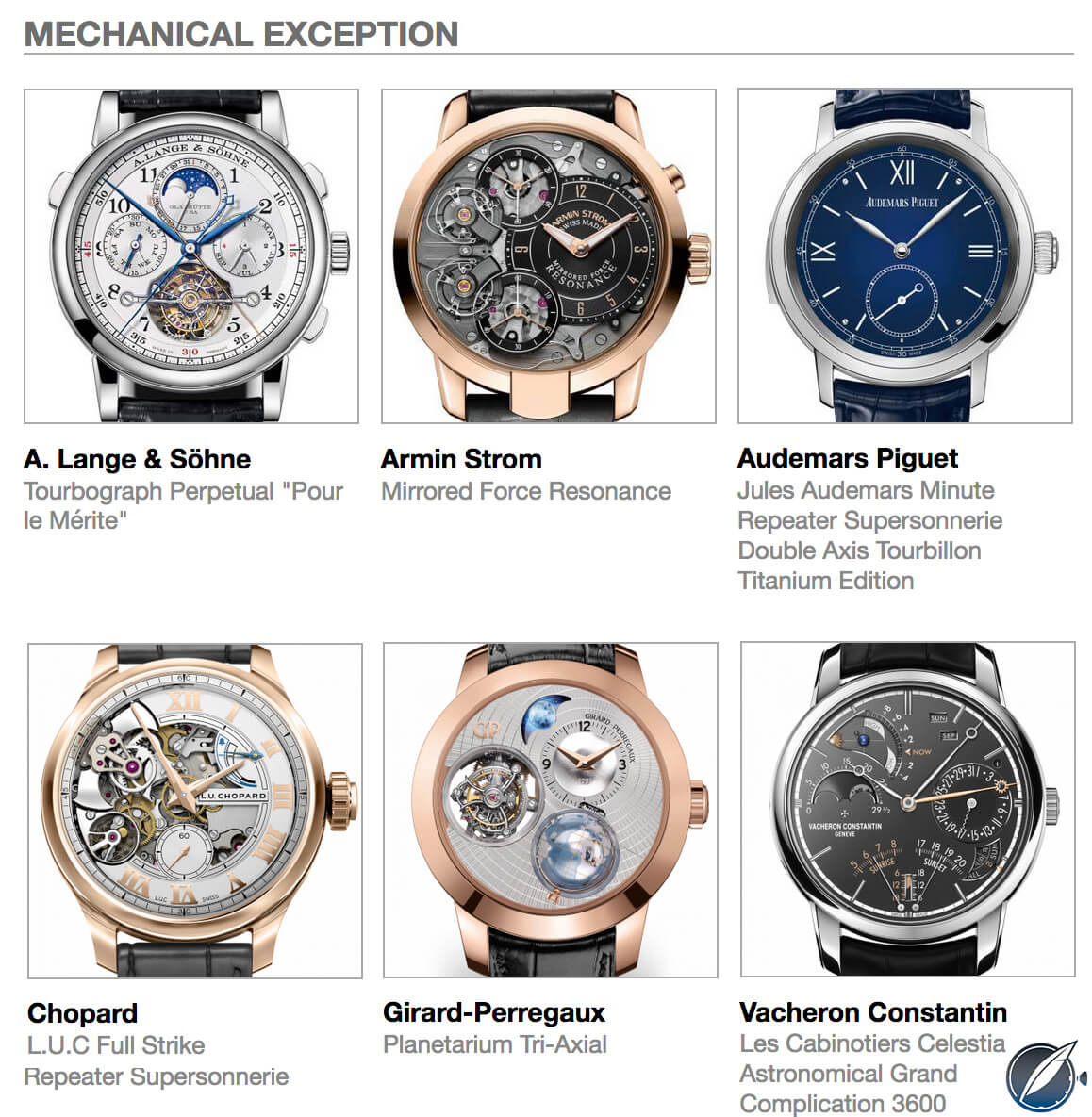
Shortlisted Mechanical Exception watches competing in the 2017 GPHG
MG: Mechanical Exception is still one of the craziest categories. Each of these watches has an incredible amount of talent, time, and resources invested in it. I don’t think that there is any other industry where we go to such trouble to perfect a technology that is by all means obsolete, and that is why I love it so much.
IS: While the 2017 Ladies’ High-Mech category couldn’t find six suitable qualifying watches to pre-select, the 2017 Mechanical Exception category is a vintage year: I honestly would not be upset if the jury selects any of the six pre-selected finalists. What a field to have to choose from!
JM: Now this is a category filled with heavy hitters, so much so that I would be hard pressed to argue that any one doesn’t deserve to be recognized for the mechanical prowess on display. Of course I have my favorites, and I will do my best to reason why some are more deserving than others, but each one is a seriously complicated piece, and each one is on my “when I win the lottery” list.
That being said, I think this category takes on two realities: which ones I think should win, and the probability that they may actually win. Given some interesting inclusions and exclusions so far this year in other categories, I wonder if there may be a bit more influence than usual regarding brand politics leading to different outcomes than I might anticipate. My choices will reflect this duality.
RS: This is regularly my favorite category, and the selection this year is staggering. I am going to have to be brutal to come to any sense of a conclusion, so expect no punches to be pulled!
A. Lange & Söhne Tourbograph Perpetual Pour le Mérite
MG: Every time A. Lange & Söhne presents a new addition to the Pour le Mérite collection, I think that the brand cannot possibly outdo itself; fortunately, it always proves me wrong! While this watch has a very impressive array of complications, I think that the fusée-and-chain element is still the main appeal. That is also the mystery of this watch: where do the engineers find all the space to include these complications without allowing the case to grow to Godzilla-size proportions?
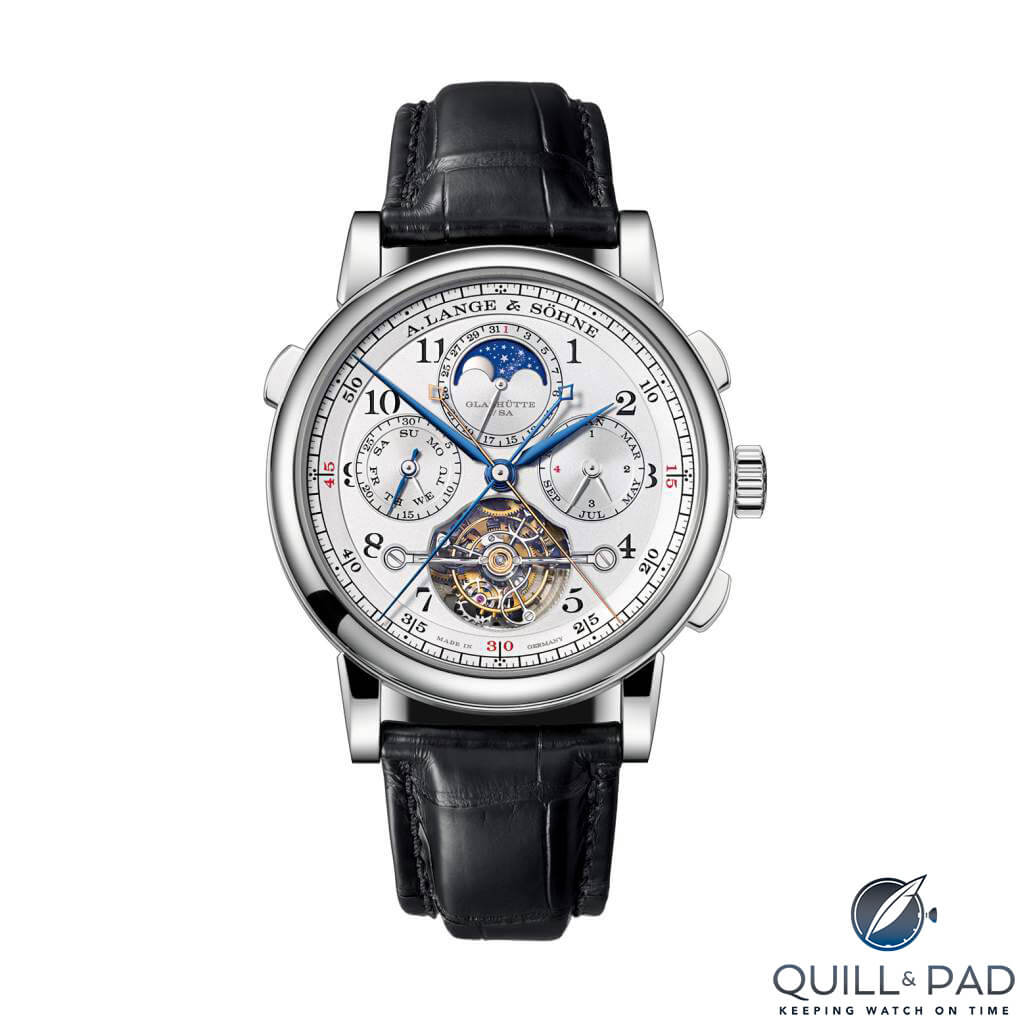
A. Lange & Söhne Tourbograph Perpetual Pour le Mérite
IS: There can be no clearer statement of just how competitive the Mechanical Exception category is this year than the fact that the A. Lange & Söhne Tourbograph Perpetual Pour le Mérite is my number six pick. You want complications and indications, then how about hours, minutes, date, day, month, year, moon phase, tourbillon, chronograph, split-seconds chronograph, perpetual calendar, and – the pièce de résistance – fusée-and-chain constant force escapement? Plus there’s the impeccable handfinishing and very wearable 43 mm case.
The A. Lange & Söhne Tourbograph Perpetual Pour le Mérite is a sensational watch, but it doesn’t offer enough innovation to make my cut as the winner of the GPHG’s 2017 Mechanical Exception category.
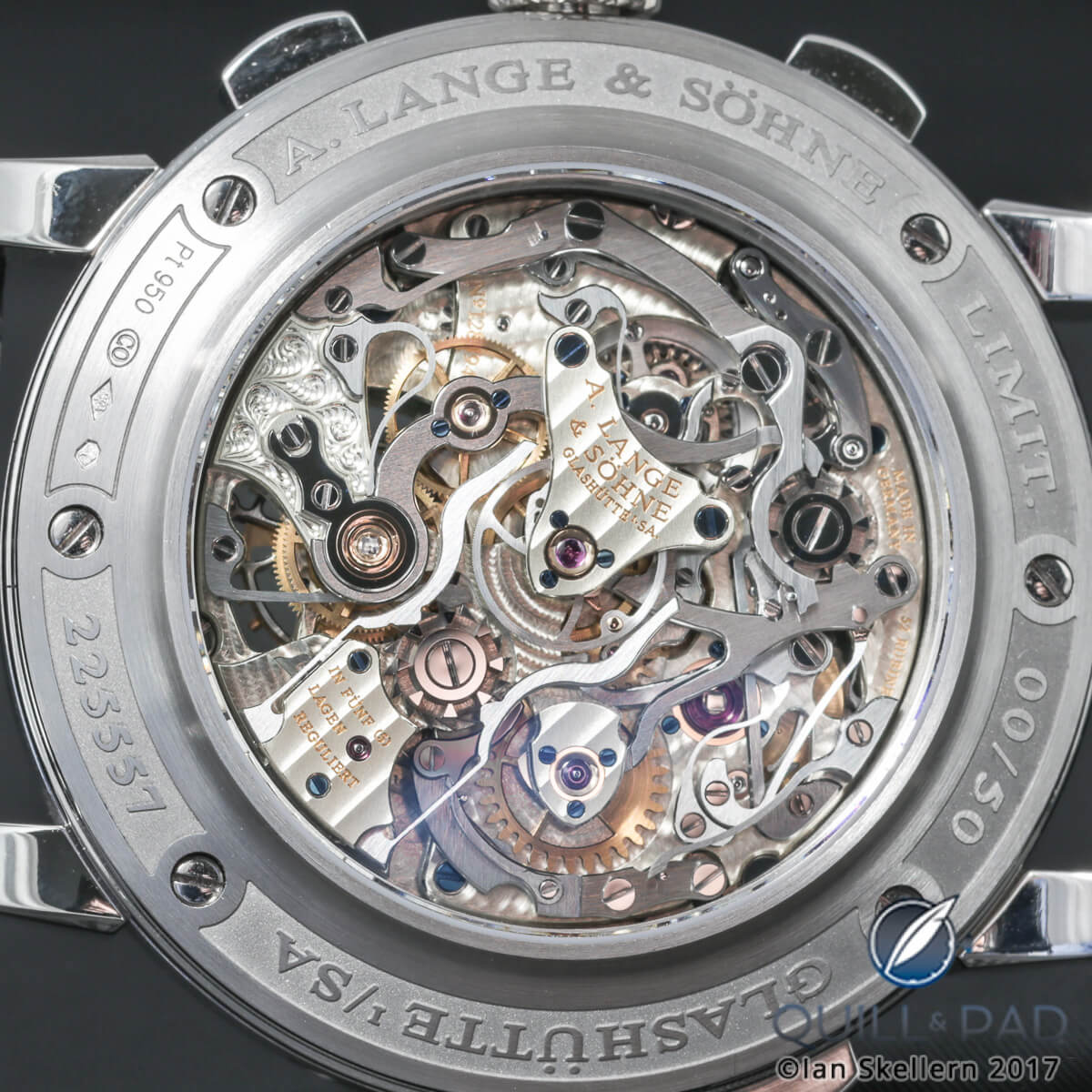
Beautifully finished movement of the A. Lange & Söhne Tourbograph Perpetual Pour le Mérite
GG: Against the two powerhouses that are the Vacheron Constantin and Chopard timepieces, other splendid watches in this set of finalists fall behind in my view. The Tourbograph Perpetual Pour le Mérite – which combines a tourbillon, chain-and-fusée drive, chronograph, and perpetual calendar – is certainly not short on complications, but lacks the coherence of the Vacheron Constantin’s focus on astronomical displays. And the construction of the Tourbograph leaves me with the slightly unhappy feeling of seeing a perpetual plate layered on top of the pre-existing Tourbograph.
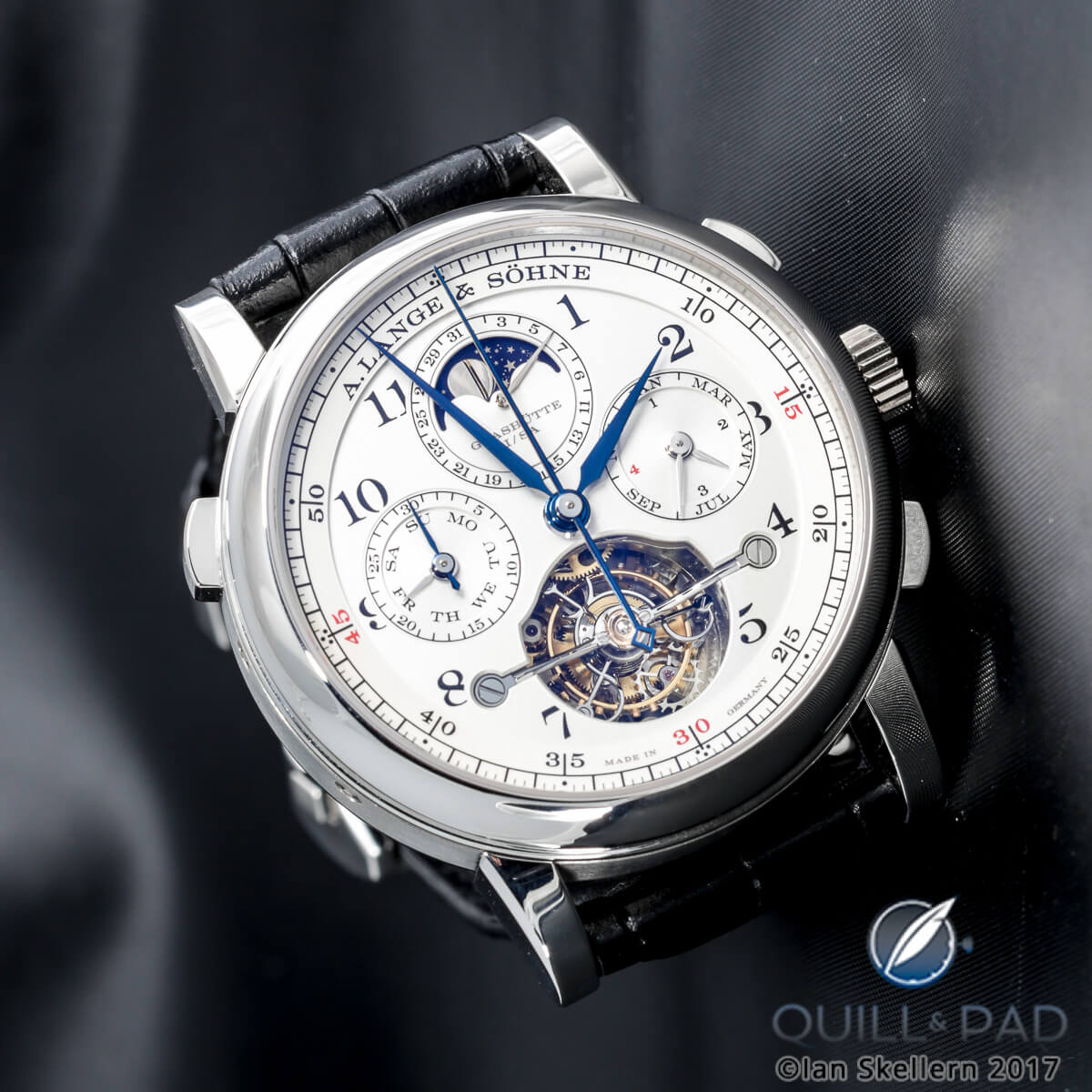
A. Lange & Söhne Tourbograph Perpetual Pour le Mérite
RS: Let me be clear that this watch is a masterpiece, but in the spirit of brutally culling this list I will take two issues with it. First, the complications are mechanically challenging to combine for sure, but they are traditional. There is nothing new but for their combined complexity. I want to hand the trophy to the watch that blows me away and has me reaching for a textbook to understand. Second is the combination of complications: I love the fusée and chain, but I would swap it for a big date and a power reserve indicator. And feel free to leave the view of the tourbillon to the case back. Paging the Saxonia Datograph Perpetual Tourbillon!
Where has A. Lange & Söhne been these last three years and why was that watch not stealing the show last year??
Further reading: A. Lange & Söhne Tourbograph Perpetual Pour Le Mérite: Building On Foundations
For more information see www.gphg.org/horlogerie/en/watches/tourbograph-perpetual-pour-le-merite and/or www.alange-soehne.com/en/news-and-more/tourbograph-perpetual-pour-le-merite.
Quick Facts A. Lange & Söhne Tourbograph Perpetual Pour le Mérite
Case: 43 x 16.6 mm, platinum
Movement: manually winding Caliber L133.1 with fusée-and-chain transmission and one-minute tourbillon; 36-hour power reserve; 21,600 vph / 3 Hz frequency
Functions: hours, minutes; split-second chronograph with minute counter, perpetual calendar, moon phase
Price: €480,000 / 525,000 Swiss francs
Audemars Piguet Jules Audemars Minute Repeater Supersonnerie
MG: You could almost forget that Audemars Piguet makes other models aside from the Royal Oak and the Royal Oak Offshore. While I love the technology behind this watch and adore the dial, I can unfortunately only conclude that it is more in its rightful element inside a large Royal Oak case. At 43 mm in diameter and 13.16 mm in height in heavy platinum, this is more a pocket watch than a wristwatch.
Audemars Piguet is obviously well aware of this, as the designer put a cone-shaped ring between the dial and the case to make the watch look smaller. Oversized is cool in a sports watch, but not in a dress watch no matter how complicated it is.
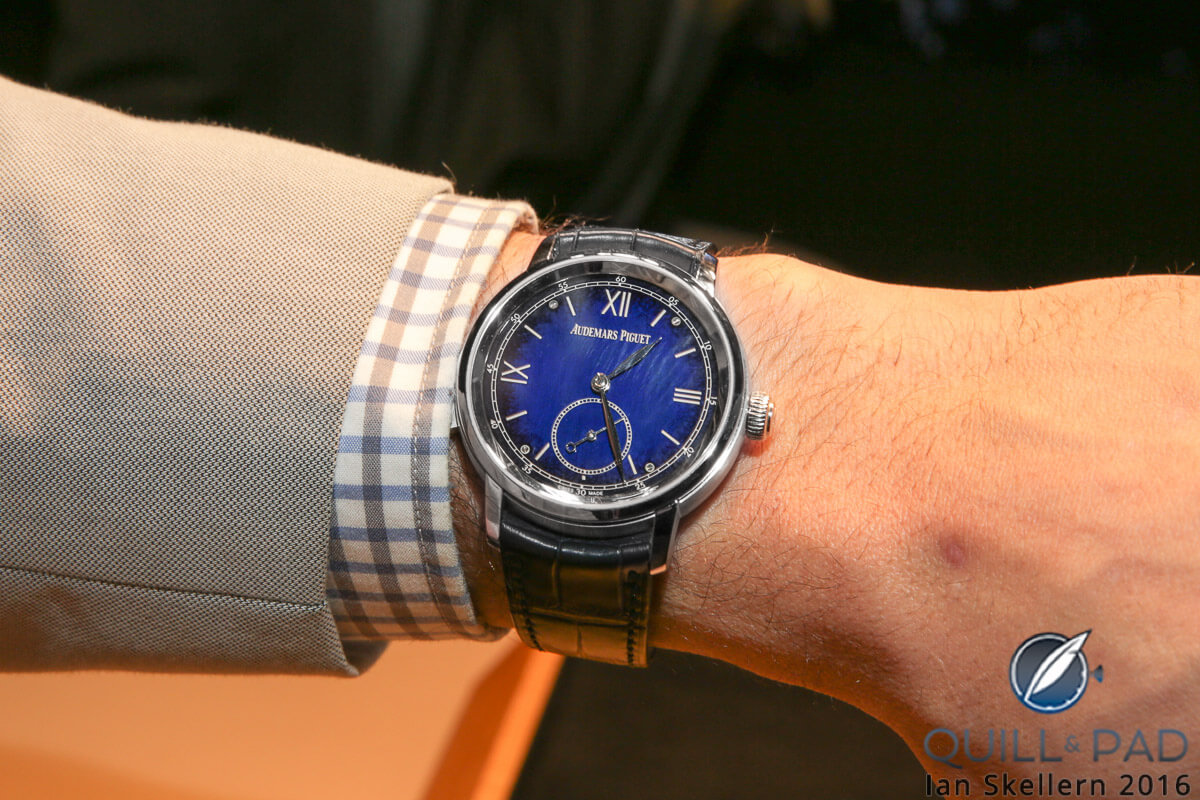
Jules Audemars Minute Repeater Supersonnerie on the wrist
IS: I have to confess, I was wrong earlier when I stated, “There can be no clearer statement of just how competitive the Mechanical Exception category is this year, than the fact that the A. Lange & Söhne Tourbograph Perpetual Pour le Mérite is my number six pick,” because of the fact that I’m also relegating the Audemars Piguet Jules Audemars Minute Repeater Supersonnerie to the bottom of my list. And it is exactly the type of technology-pushing watch that I love.
But there are two things that have changed since I first saw or, more importantly, first heard, the prototype Supersonnie at the 2015 SIHH: for one, the Royal Oak Supersonnerie version won the Mechanical Exception category last year, which makes this Jules Audemars version in a way less exceptional; and for another other superlative-sounding sonneries have arrived, including the Greubel Forsey Grande Sonnerie and Chopard L.U.C. Full Strike, which have made the Supersonnerie seem less exceptional.
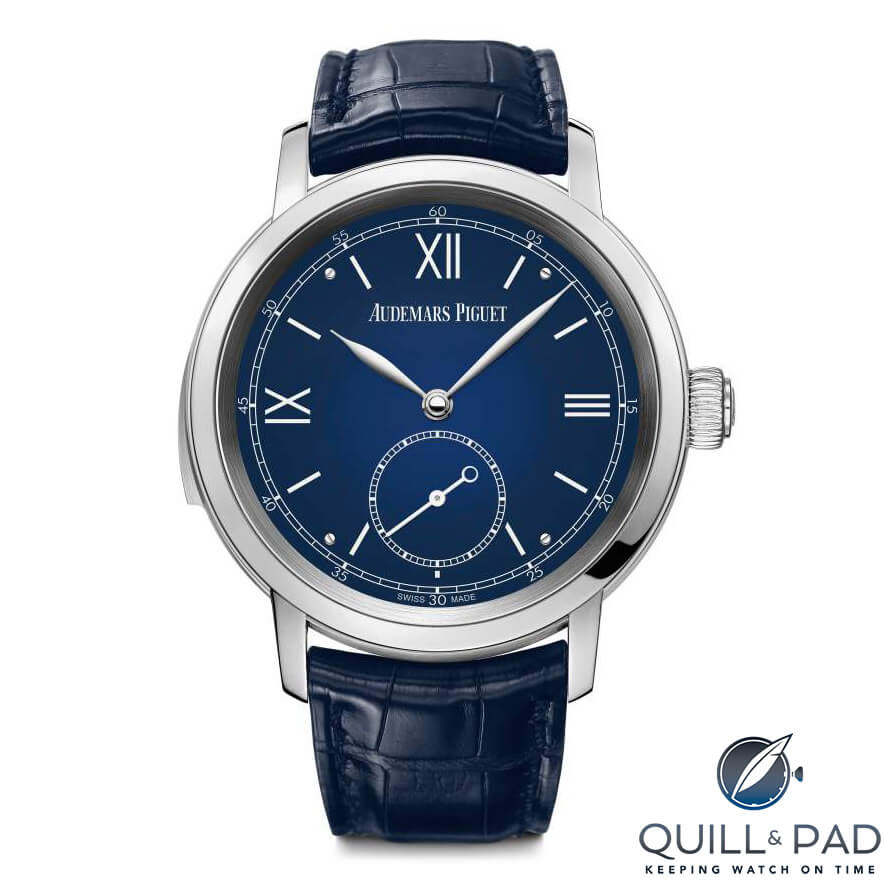
Audemars Piguet Jules Audemars Minute Repeater Supersonnerie
GG: The Supersonnerie was a favorite of mine at SIHH with its blue dial and brilliant sound, but for me has been pushed down the ranks by the Chopard here too, Ian.
Still, the A. Lange & Söhne Tourbograph Perpetual Pour le Mérite and Audemars Piguet Jules Audemars Minute Repeater Supersonnerie are impressive enough to tie for third in my view.
RS: The Audemars Piguet is a superb sleeper watch: simple and elegant above the enamel dial, devilishly complicated beneath it. But it doesn’t cut the mustard in this category. Think that’s abrupt? Take a look at the description submitted by Audemars Piguet to the GPHG website!
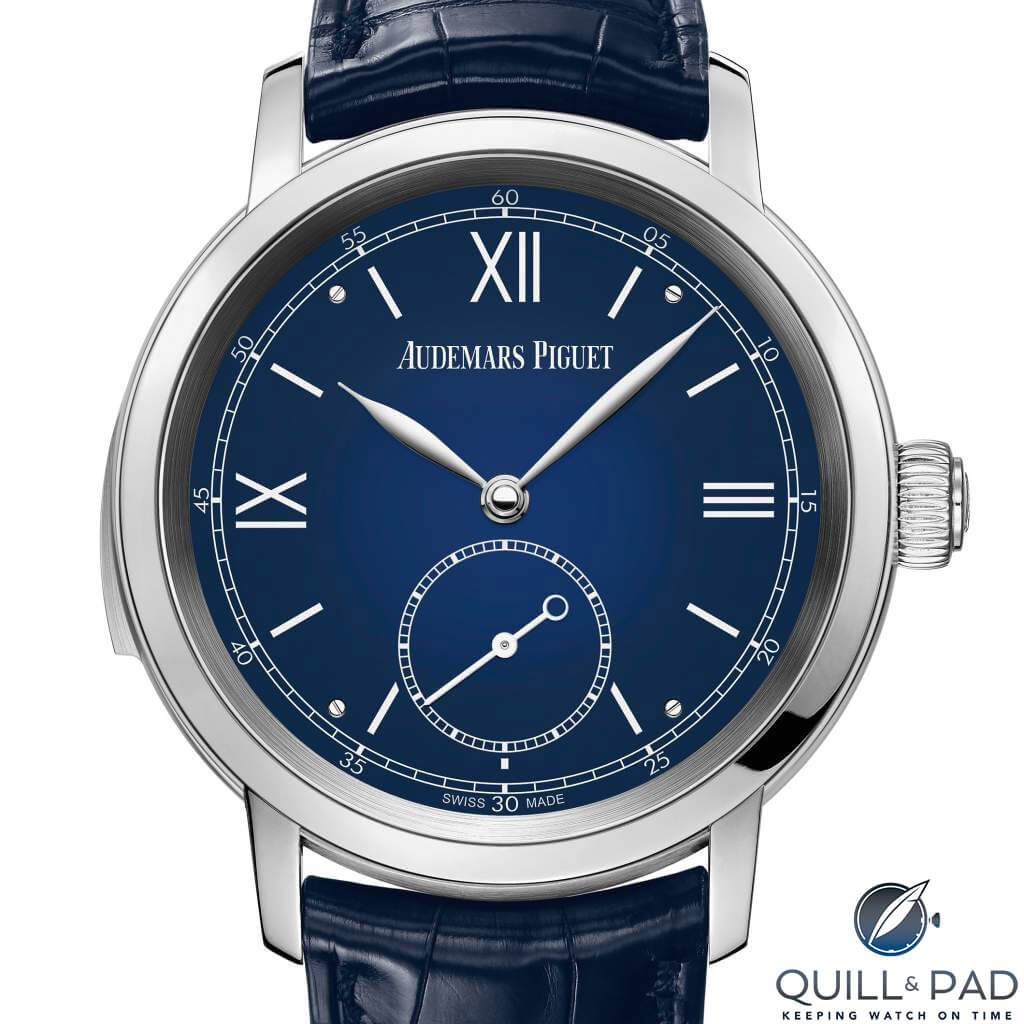
Audemars Piguet Jules Audemars Minute Repeater Supersonnerie
Further reading: Hearing Is Believing: Audemars Piguet Royal Oak Supersonnerie And The Science Of Sound
For more information see gphg.org/horlogerie/en/watches/jules-audemars-minute-repeater-supersonnerie and/or www.audemarspiguet.com/en/watch-collection/jules-audemars.
Quick Facts Audemars Piguet Jules Audemars Minute Repeater Supersonnerie
Case: 43 mm x 13.16 mm, platinum
Movement: manually winding manufacture Caliber 2944; 21,600 vph / 3 Hz frequency; 72-hour power reserve
Functions: hours, minutes; minute repeater on two gongs
Price: 325,500 Swiss francs
Girard-Perregaux Planetarium Tri-Axial
RS: The Girard-Perregaux Planetarium Tri-Axial is a very attractive watch, and a triple-axis tourbillon cannot be scoffed at. I think the thing that I love the most about this watch is what appears to be the most whimsical execution of a dual time zone/world time complication I have ever seen! I am not talking about the use of a globe as such – this has been done before and done very well.
It’s how casually the globe is used to indicate the second time zone that has me chuckling to myself for some reason. Ask the wearer of this watch what time it is in Los Angeles and he or she may well be able to answer you, but it will likely require taking the watch off, studying it from all angles, and providing you with an approximate time rounded to the nearest meal! You would think that such a watch would infuriate, but I absolutely love it. Just not enough to give it an award in this category.
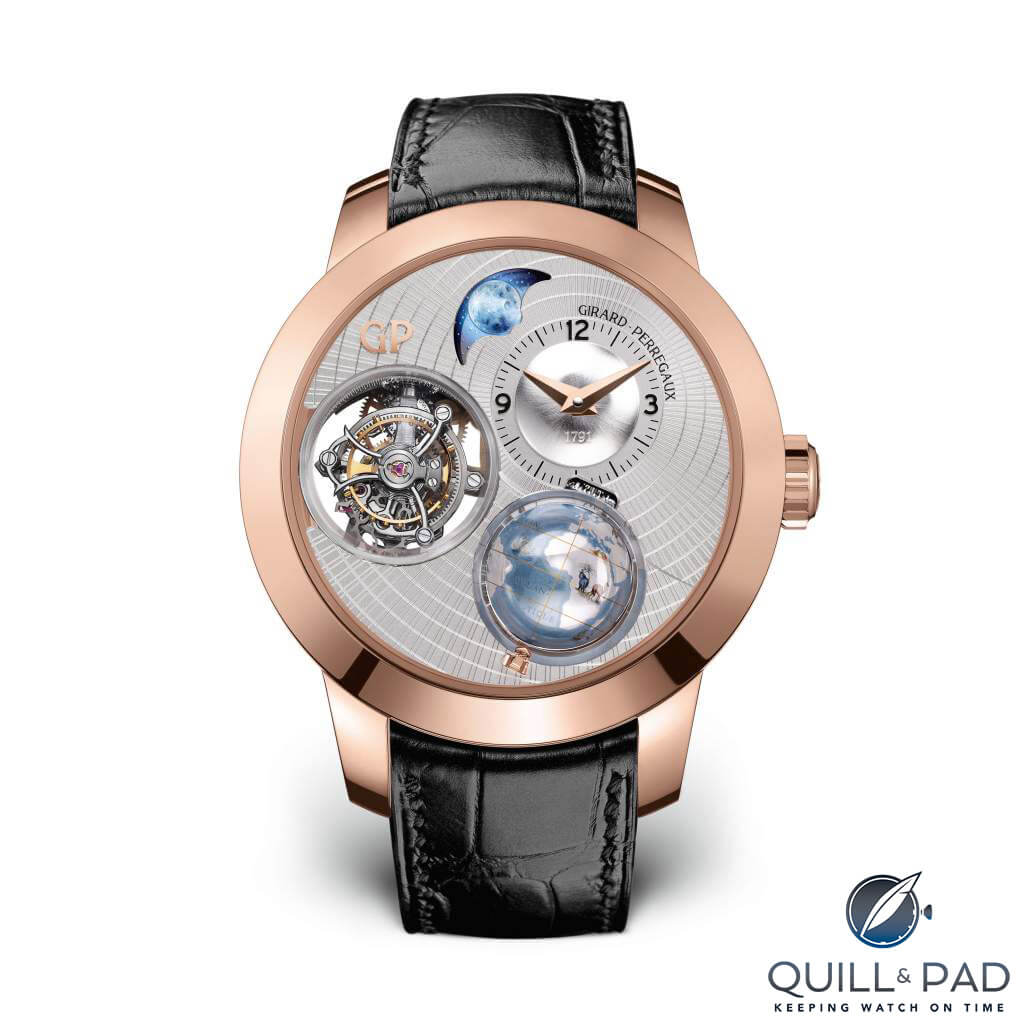
Girard-Perregaux Planetarium Tri-Axial
MG: There is something about the Girard-Perregaux Planetarium Tri-Axial that I find very pleasing. The dial is clean and I like the two domes that allow you to admire the tri-axial tourbillon and the globe in even greater detail.
Visual splendor triumphed over all, though, as I do not find it easy to read the time zones from a rotating globe, on this or any other watch. But that doesn’t matter as we have long passed the line separating sensible mechanical watches and are deep into the woods of micromechanical art.
IS: There’s a magical quality to having three-dimensional indications beyond the technical practicality of being a more easily visualized and closer representation of reality than two-dimensional indications, and the Girard-Perregaux Planetarium Tri-Axial tourbillon uses this to full effect.
A triple-axis tourbillon is about as mechanically exceptional as complications come, and added to that a three-dimensional rotating globe with day/night indication (very practical for frequent travelers) and photorealistic moon phase display. While at 48 mm the Planetarium Tri-Axial is very much on the large size, the clean layout of the displays on the dial shows how the size was necessary to achieve pleasing proportions. And with that, such is the competition this year that a triple-axis tourbillon fails to make my top three.
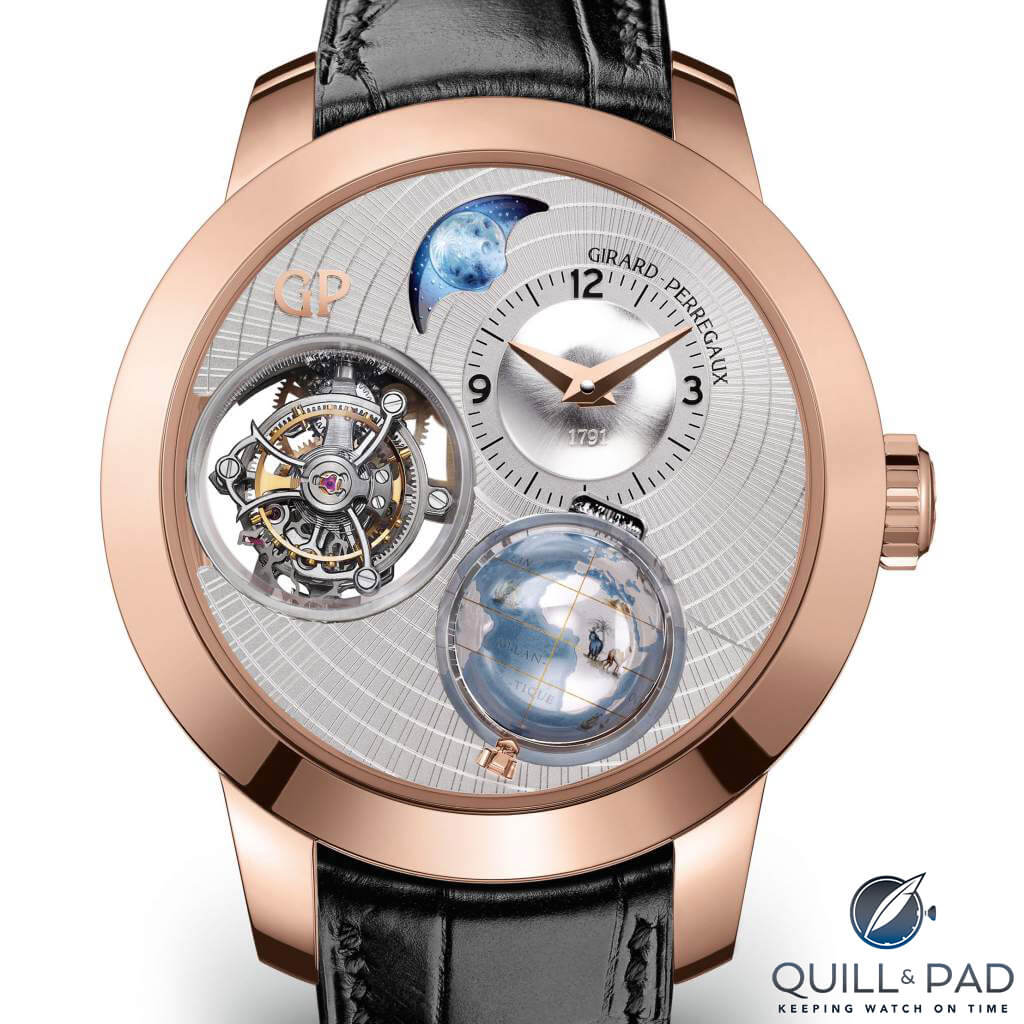
Girard-Perregaux Planetarium Tri-Axial
For more information see www.gphg.org/horlogerie/en/watches/planetarium-tri-axial and/or www.girard-perregaux.com/en/bridges/planetarium-tri-axial.
Quick Facts Girard-Perregaux Planetarium Tri-Axial
Case: 48 x 18.66 mm, pink gold
Movement: manually winding Caliber GP09310-0001 with tri-axial tourbillon; 60-hour power reserve; 21,600 vph / 3 Hz frequency
Functions: hours, minutes; moon phase, second time zone with day/night indication (global time)
Price: 273,100 Swiss francs
Chopard L.U.C Full Strike
GG: Despite my deep admiration for the Vacheron Constantin, it was hard for me not to pick the Chopard L.U.C Full Strike. To my way of thinking every box has been ticked, from the elimination of gaps between the chiming of hours, quarters, and minutes to the silent regulator and safeguards against damaging the mechanism. The single block of sapphire crystal that is carved into an integrated crystal and gong set is both technically brilliant and sonically gorgeous, all the way down to the precise spacing of the gong sounds on musical notes C and F. And, I even like the idea of powering the repeater with a separate power storage train that is charged by reverse winding of the crown in the style of a sonnerie. It’s beautifully finished, and I also love the treat of seeing the repeater works doing their thing on the dial side of the watch.
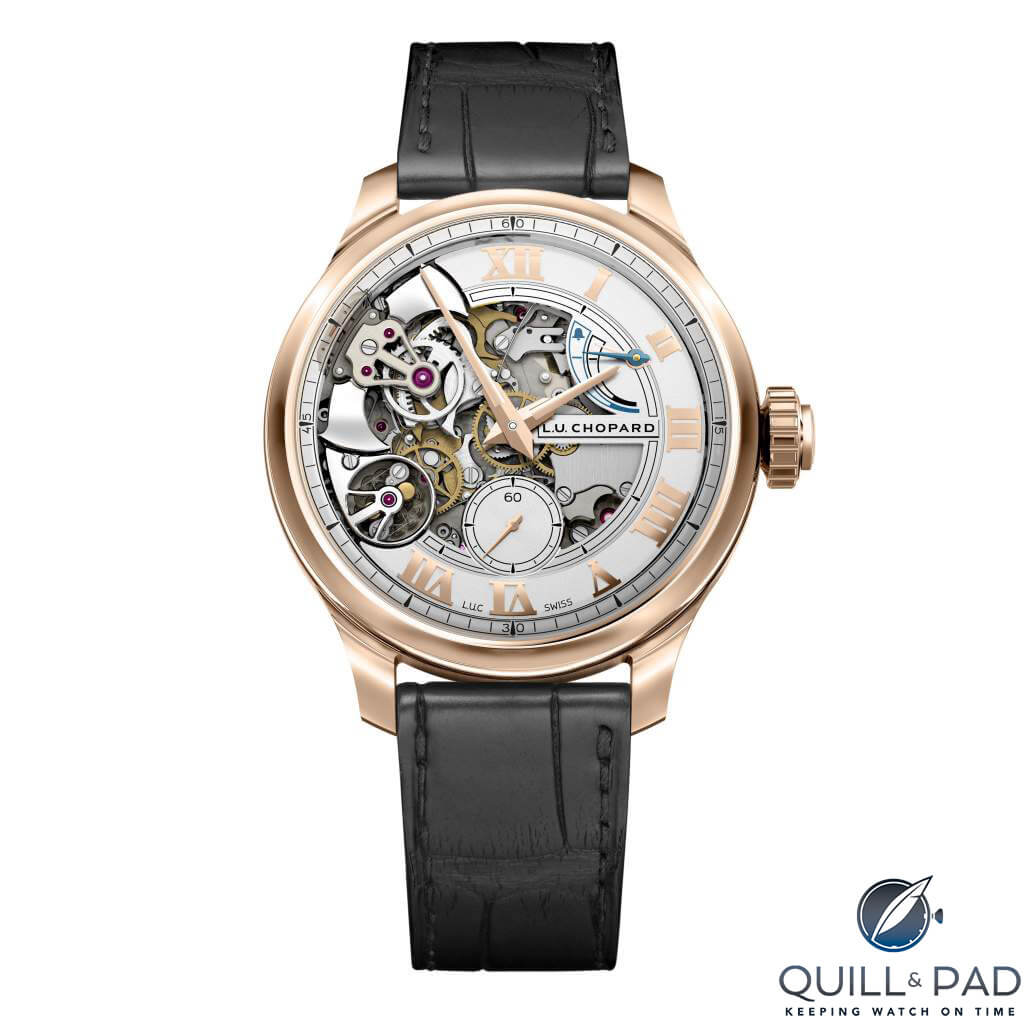
Chopard L.U.C Full Strike
JM: This is a ridiculously awesome and advanced watch with components I would have guessed we still wouldn’t have seen for years. Chopard has created something amazing with the L.U.C. Full Strike, and the sound proves hard to dismiss. The technical innovation is scintillating, and even when compared with another amazing contender, the Audemars Piguet Jules Audemars Minute Repeater Supersonnerie, the Full Strike stands out as an impeccable and lovely minute repeater.
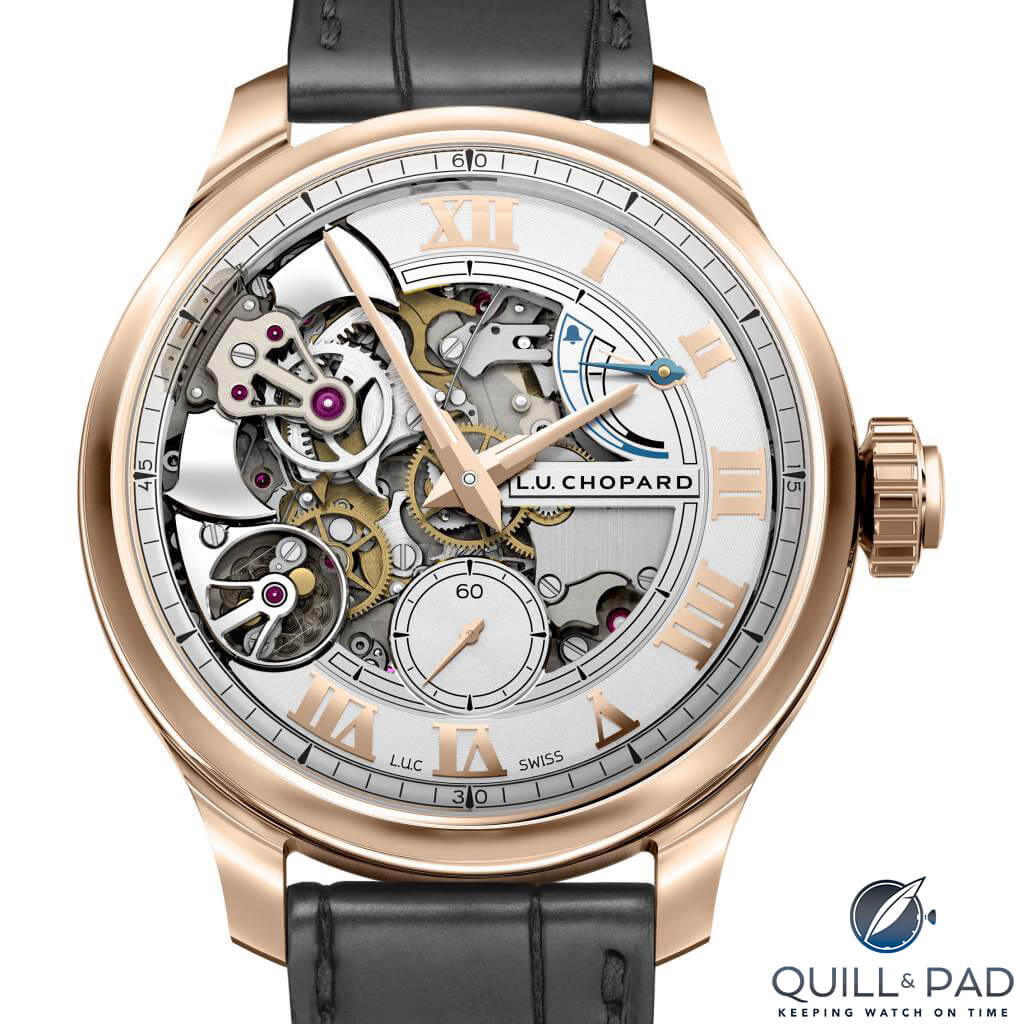
Chopard L.U.C Full Strike dial
Visually, it is interesting without being overbearing, something that watches in the Mechanical Exception category cannot always say. And unlike the AP, the Full Strike is the first iteration of this new technology, which, at least for some jury members and here on our Quill & Pad panel, matters when it comes to which one deserves to win this year.
I fear that Chopard has an uphill battle, though, against names like Vacheron Constantin, Audemars Piguet, and A. Lange & Söhne, and might lose out simply because the horological name recognition isn’t as high as the others.
That being said, I believe it most likely deserves to be crowned the champion out of this group. It demonstrates everything the Mechanical Exception category is about.
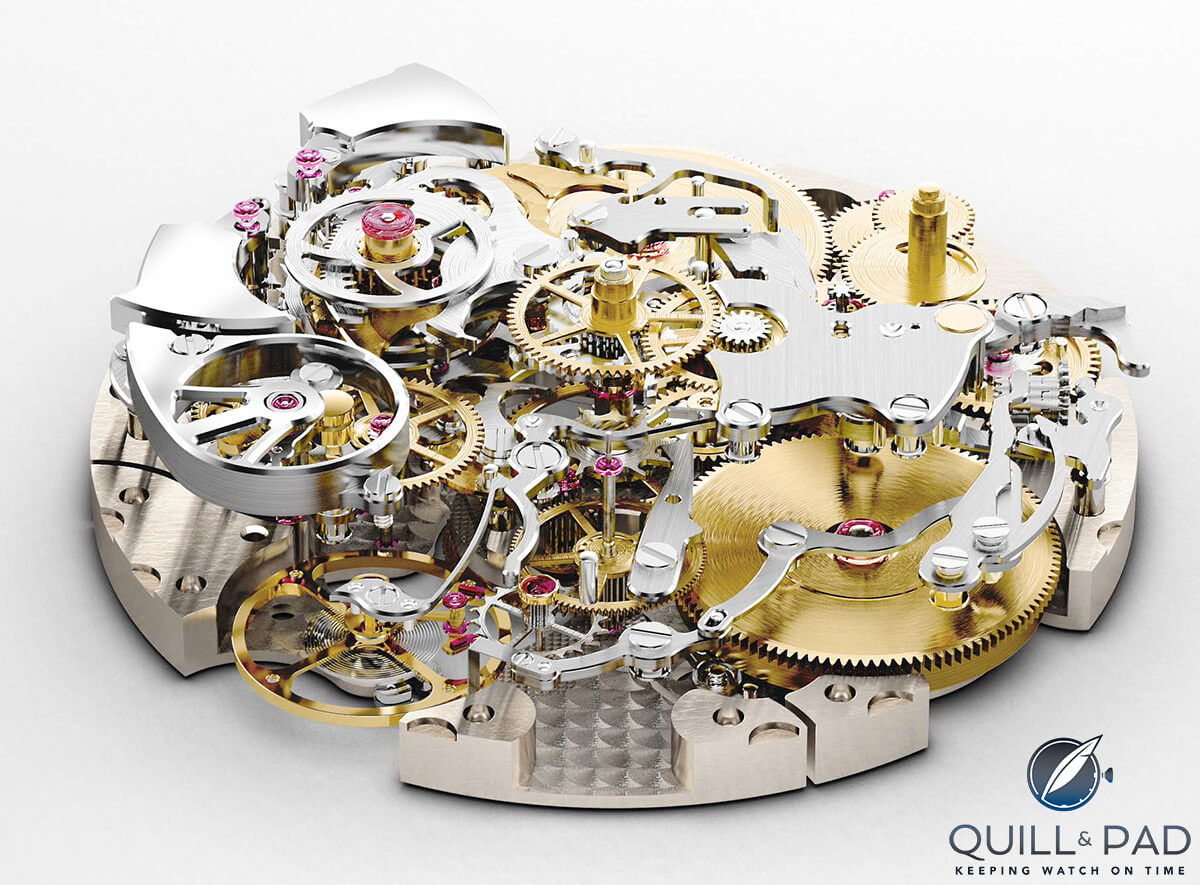
Chopard L.U.C Full Strike minute repeater movement
RS: The Chopard L.U.C Full Strike gets my second place vote, which is absurd really because, well, just look at it!
There is so much to say about this watch, much of which has been said already, but the crystal gongs are a victory unto themselves. There is something poetic, magical, triumphant, and perplexing about a chiming watch that generates its sound by hammering steel against sapphire crystal. It’s the watchmaking equivalent of a proposed toast at an horological dinner table. It’s enough to cause me to pause mid-swig on my cabernet – but the fact that the crystal gongs are integrated into the watch crystal and machined from the same block has me spitting rouge across the whole table. What a watch.
MG: I still think that Chopard should have given this watch a different name, as Full Strike is not only confusing, it doesn’t sound nearly as good as “Crystal Strike.” The sound of this minute repeater is beautiful and crystal clear (pun intended), but the fact that the dial is largely sacrificed to show all this is a pity as it gives the watch a bit of an unbalanced look.
Personally, I would love it if Chopard put more emphasis on the crystal gongs in this watch and made a dial from smoked crystal with gold appliqué numerals on it.
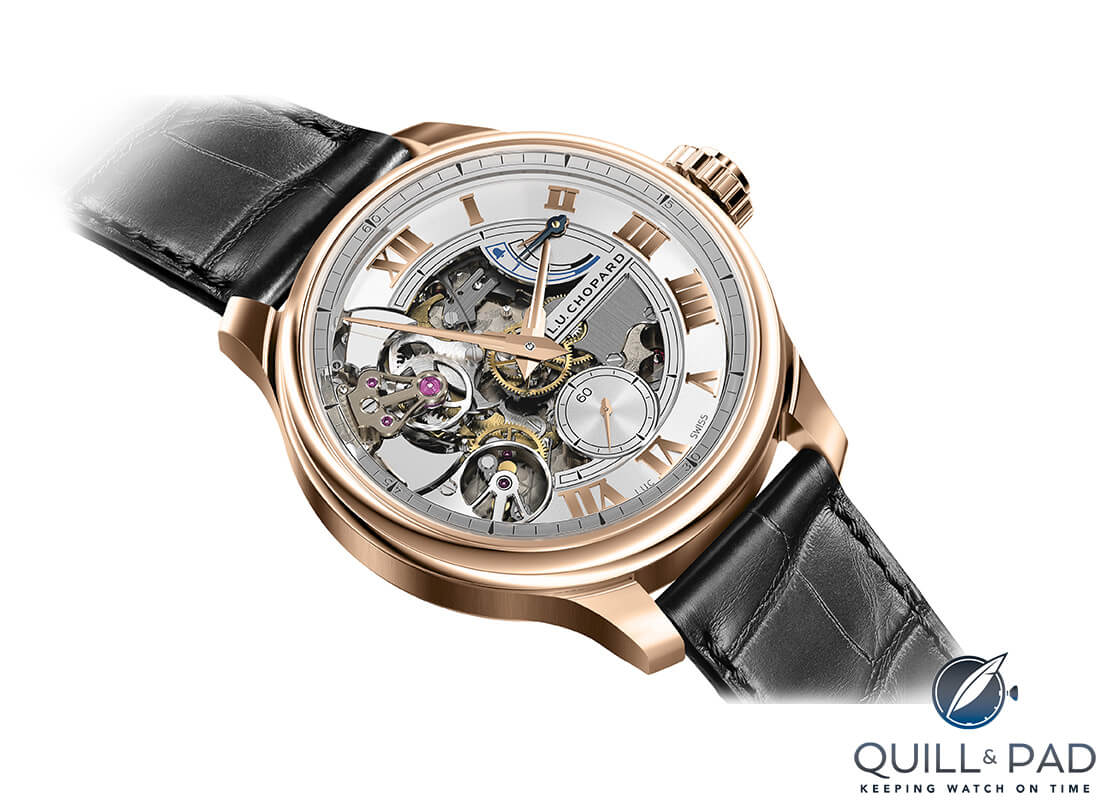
Chopard L.U.C Full Strike minute repeater
IS: When I first heard the Chopard L.U.C Full Strike it was across a noisy Baselworld press room and I was impressed. And I’m still impressed; both by how well Chopard has made a minute repeater and the innovative way the brand did it. To make a traditional minute repeater is an incredible achievement in itself for any watch manufacture, but Chopard went further and developed new sound propagation technology: the gongs are not just attached to the sapphire crystal covering the dial, they are an integral part of the crystal. And Chopard has eliminated the sometimes-uncomfortable pauses between the strikes when there are less than three quarters to chime.
I’m continually surprised by the paucity of useful information and lack of seriousness that the brands give to the watch description texts that they send GPHG for the website, but Chopard deserves a shout out because under “Functions” are listed: hours, minutes, seconds, power reserve. There is no mention of the minute repeater that got this watch pre-selected in the technical specifications at all.
The integrated sapphire crystal gong and crystal isn’t the only innovation in Chopard’s Full Strike; the chiming mechanism claims the world’s longest power reserve and can chime 12:59 (the time with the most strikes) up to 12 times without winding again.
And at 42.5 mm in diameter, the Full Strike is eminently wearable. I’m sure that the Chopard L.U.C Full Strike will get more than a few votes from the jury for the top slot here, but I’m voting it as my number three pick.
Further reading: Chopard L.U.C Full Strike Minute Repeater With Crystal Power! Plus Video: Listen For Yourself
For more information see www.gphg.org/horlogerie/en/watches/luc-full-strike and/or www.chopard.com/us/l-u-c-full-strike.
Quick Facts Chopard L.U.C Full Strike
Case: 42.5 x 11.5 mm, 18-karat Fairmined pink gold
Movement: manual winding Caliber 08.01-L with 60-hour power reserve and sapphire crystal gongs; C.O.S.C. certification; Geneva Seal
Functions: hours, minutes, seconds; minute repeater, power reserve, minute repeater power reserve
Limitation: 20 pieces
Price: 245,000 Swiss francs
Vacheron Constantin Les Cabinotiers Celestia Astronomical Grand Complication 3600
MG: Twenty-three complications, a three-week power reserve, and all that in a watch with a diameter of only 45 mm and a height of 13.6 mm. I want this Vacheron Constantin to win as I find it an absolute masterpiece from a technical perspective!
But visually I find it a very unsatisfying watch: every function has a place and all are even easy to read, but they don’t relate to each other. It is more a dashboard than an integrated piece of art. I also miss the typical Vacheron Constantin feel: I understand that with a watch this complicated form must follow function, but at least the brand’s designers could have done something more exciting with the case.
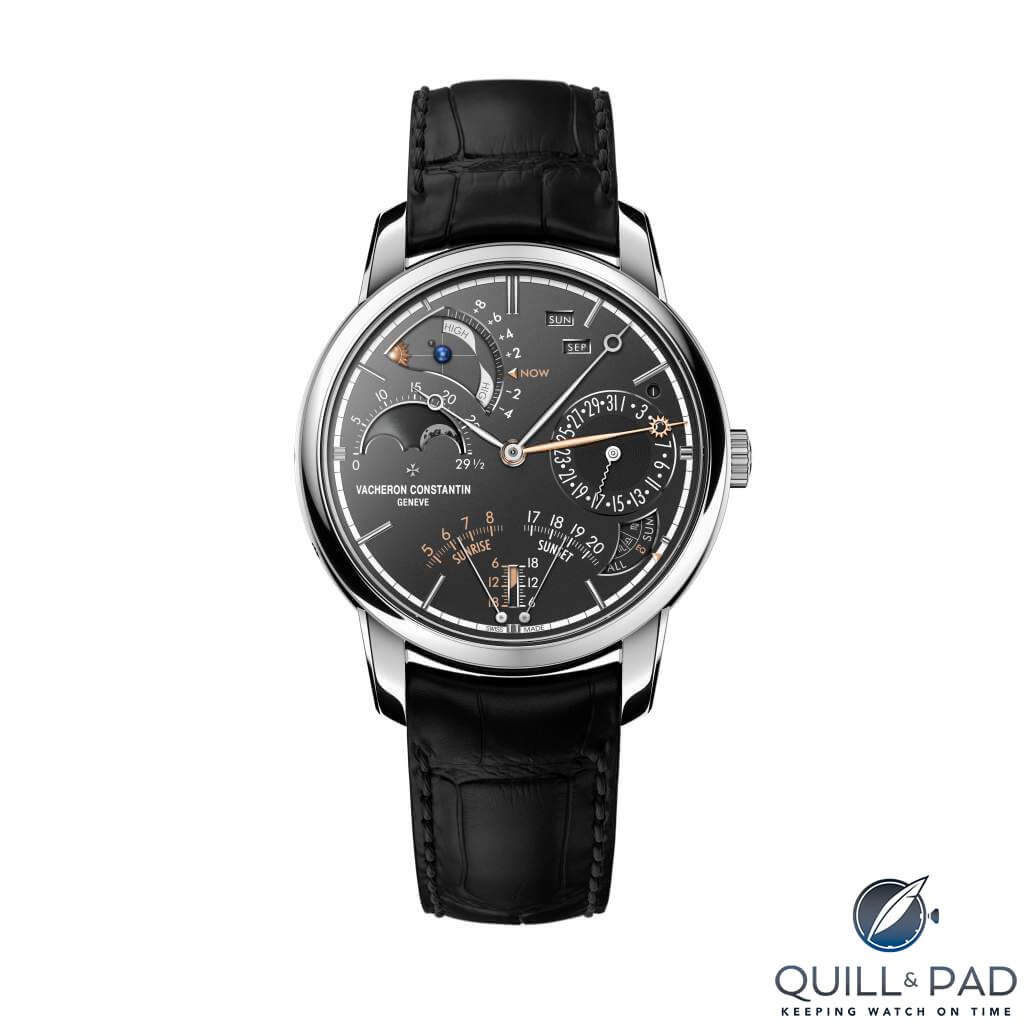
Vacheron Constantin Les Cabinotiers Celestia Astronomical Grand Complication 3600
IS: If you sat down with a blank sheet of paper and started writing the ideal features that a GPHG Mechanical Exception-winning watch might have, it’s likely to contain hours, minutes, date, day, month, year, moon phase, power reserve, tourbillon, perpetual calendar, and equation of time; the Vacheron Constantin Les Cabinotiers Celestia Astronomical Grand Complication 3600 could have been made to win this competition.
And for a watch with such a plethora of indications, the dial is surprisingly logically and legibly laid out. But I’m looking for more innovation in a winner here and I’m uncomfortable in rewarding one-offs, so the Astronomical Grand Complication 3600 comes in as my number two pick.
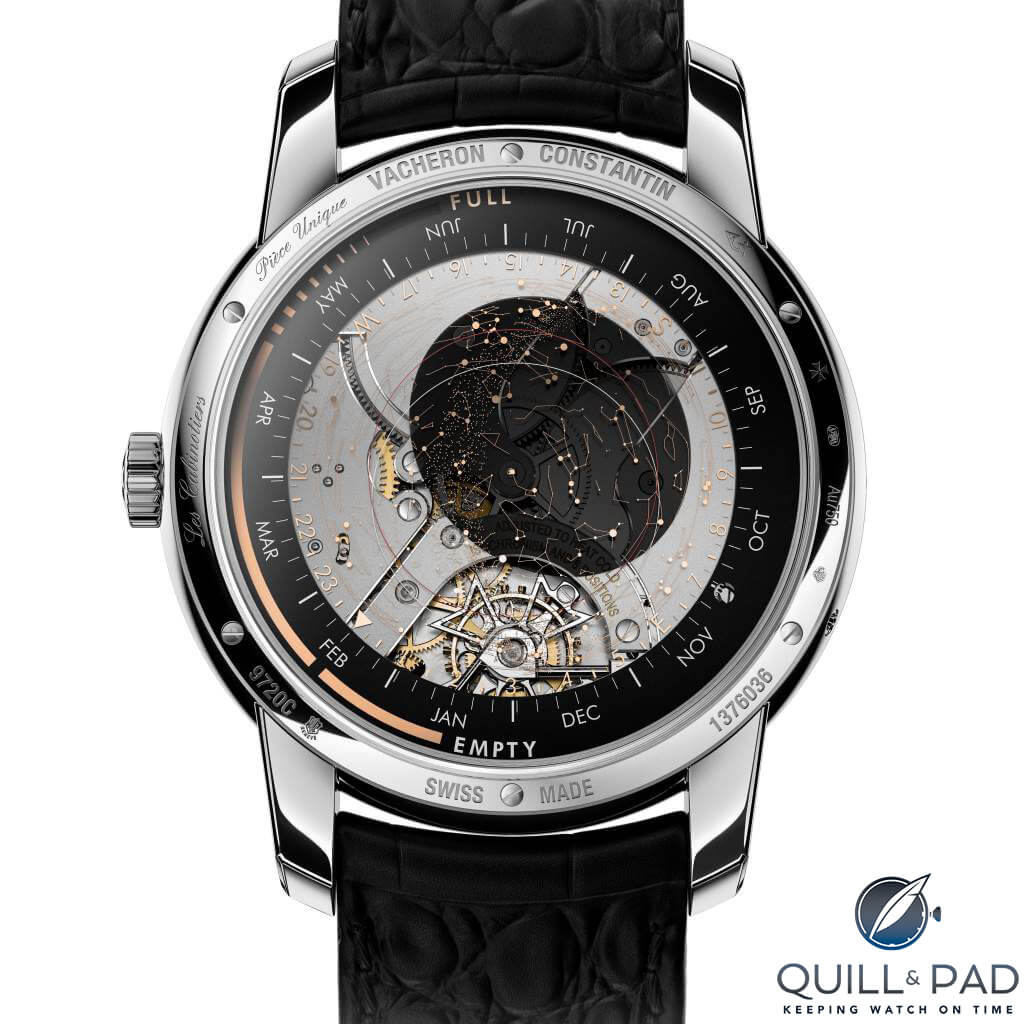
Indications on the back of the Vacheron Constantin Les Cabinotiers Celestia Astronomical Grand Complication 3600
GG: Well, it doesn’t chime, but it does pretty much everything else and looks good while doing it! Civil, solar, and sidereal time with a running equation of time, lengths of day and night, times of sunrise and sunset, and an indication of the tides are some, but not all, of the goodies packed in this watch that is still, at 45 x 13.6 mm, wearable by humans.
I like pretty much everything about this watch, from the selection of astronomic functions to the legible displays to the grey-with-white dial and case combination and pink gold accents.
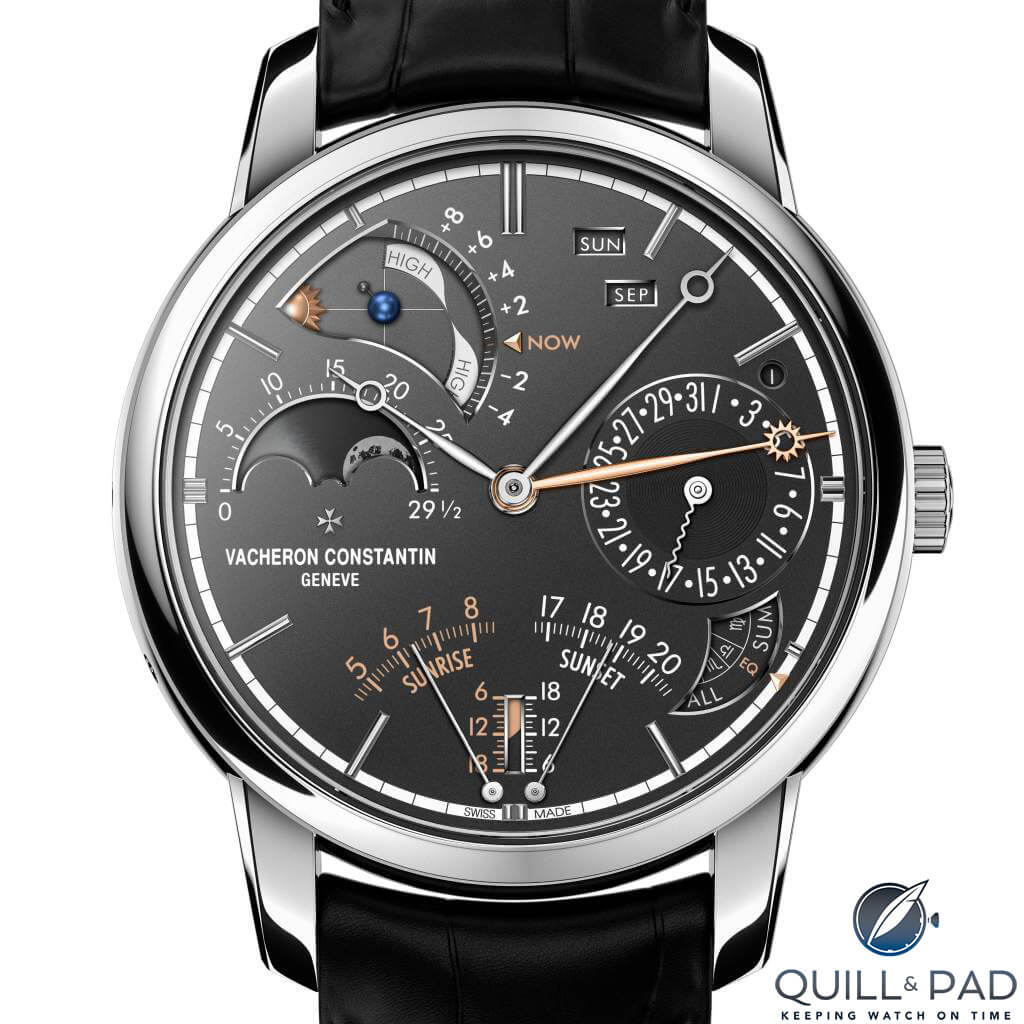
Vacheron Constantin Les Cabinotiers Celestia Astronomical Grand Complication 3600
JM: What a mouthful the name of this one is, though still not the longest in recent history. But the mechanical ingenuity to cram all of these indications into a watch of this size (seriously, I would wonder if a tiny crowbar was used to make everything fit) is worthy of applause.
It is an offspring of the epic 57260, and with the variety of astronomical and horological information presented (as well as the ways it is presented) the L.C.C.A.G.C. leaves nothing wanting. The watch is so chock full that the description of the indications isn’t a sentence but an entire paragraph. Yet many of the indications are not groundbreaking in and of themselves, simply the incredibly complex assembly.
I think that the L.C.C.A.G.C. is fantastic, but I am left feeling like I wanted something truly new and exciting. I think since it comes from the imitable Vacheron Constantin, it has a great chance of taking the top prize based on the jury, but personally I think it falls short (by however slim of a horological margin) of being the most incredible and groundbreaking Mechanical Exception piece here, even if I love the living heck out of it!
RS: Everybody knows that to win in this category you need a name that requires two breaths and a comfort break in order to announce it. The Vacheron Constantin Les Cabinotiers Celestia (are we there yet?) Astrononomical Grand Complication (not yet) 3600 is the watch that has the others in this category quivering with name-length envy. And they would do well to be afraid because this is a watch that matches its complex taxonomy with an equally complex array of indications. In the brand’s own words, Caliber 3600 “controls more than 20 functions” – even it has lost count!
But seriously, this watch is breathtaking, it’s a masterpiece, and if I am brutally honest there is nothing that comes close to it in this category. I predict that this will win both the mechanical category for 2017 and 2018 because the presenters will still be announcing it by then.
For more information see www.gphg.org/horlogerie/en/watches/les-cabinotiers-celestia-astronomical-grand-complication-3600 and/or www.sihh.vacheron-constantin.com/astronomical-watches/les-cabinotiers-celestia-astronomical-grand-complication.
Quick Facts Vacheron Constantin Les Cabinotiers Celestia Astronomical Grand Complication 3600
Case: 45 x 13.6 mm, white gold
Movement: manual-winding Vacheron Constantin Caliber 3600; 504-hour power reserve (3 weeks); 18,000 vph / 2.5 Hz frequency; Seal of Geneva; one-minute tourbillon; 6 spring barrels
Functions: hours, minutes; perpetual calendar with day, date, month, year, moon phase, running equation of time, day/night indication, age of moon, times of sunrise/sunset, length of day and night, seasons, solstices, equinoxes and zodiac signs; tide level indicator; power reserve indication; sky chart of northern hemisphere, ecliptic and celestial equator: sidereal time hours and minutes
Limitation: one unique piece
Price: not disclosed
Armin Strom Mirrored Force Resonance
MG: Few watch brands make a resonance watch – F.P. Journe and Beat Haldimann are the only other two that I can think of – even though it is such a captivating phenomenon: when this watch starts running, and you slowly see the balance wheels synchronize to each other . . . just goose bumps! The resonance clutch spring that the brand developed is the icing on the cake as it makes the twin display of the seconds possible, yet also shows off the technical prowess of Armin Strom to an even higher degree – all in that understated, modest sense the Swiss (and particularly this brand) are so famous for! For me this is the best entry in this category.
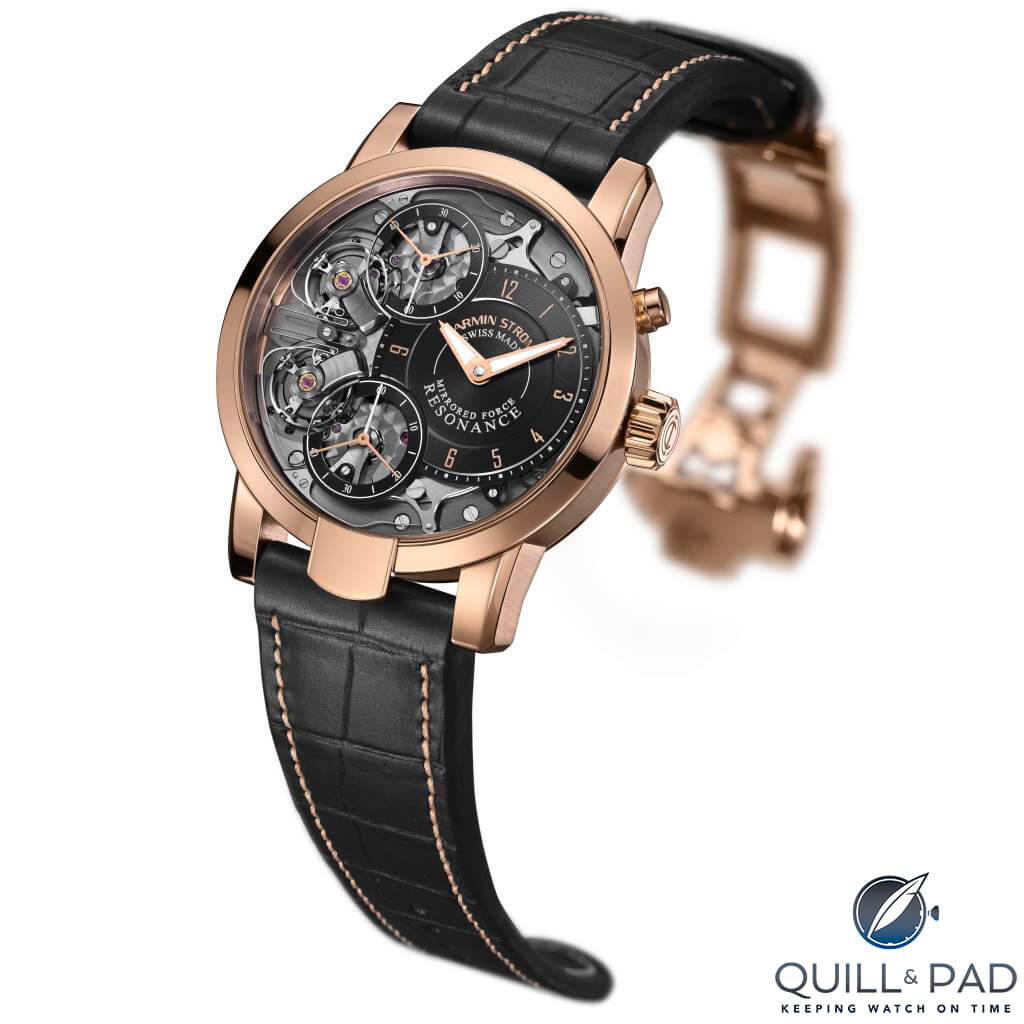
Armin Strom Mirrored Force Resonance
RS: The Armin Strom is my third choice. Anything with a resonance complication gets my heart and brain pulsating in perfect synchronicity! Visually, this is one of the most captivating mechanical complications, too. In a lesser year it would be the winner for me, but in high prejudice mode I am going to deduct a point for this imagining of resonance taking place within a mechanically coupled framework. It’s a Zimmer frame for a complication that I want to see running free!
IS: The Armin Strom Mirrored Force Resonance is my prediction for number one in the Mechanical Exception category, not because this watch utilizes the force of resonance in a wristwatch – which is a very rare achievement in itself – but because Armin Strom developed a better way to create resonance by linking two balances (actually the balance spring studs) with a patented, relatively fast-acting resonance clutch spring.
What’s not usually appreciated with the Mirrored Force Resonance is that it actually has two complete movements, but only one of them indicates the time; the other serves to make the first more accurate by averaging out errors. I’m sure that the jury will be tempted to give this prize to a big Genevan brand like Vacheron Constantin, but in my opinion Armin Strom well deserves this prize.
I’d even put the Mirrored Force Resonance in the running for the Aiguille d’Or.
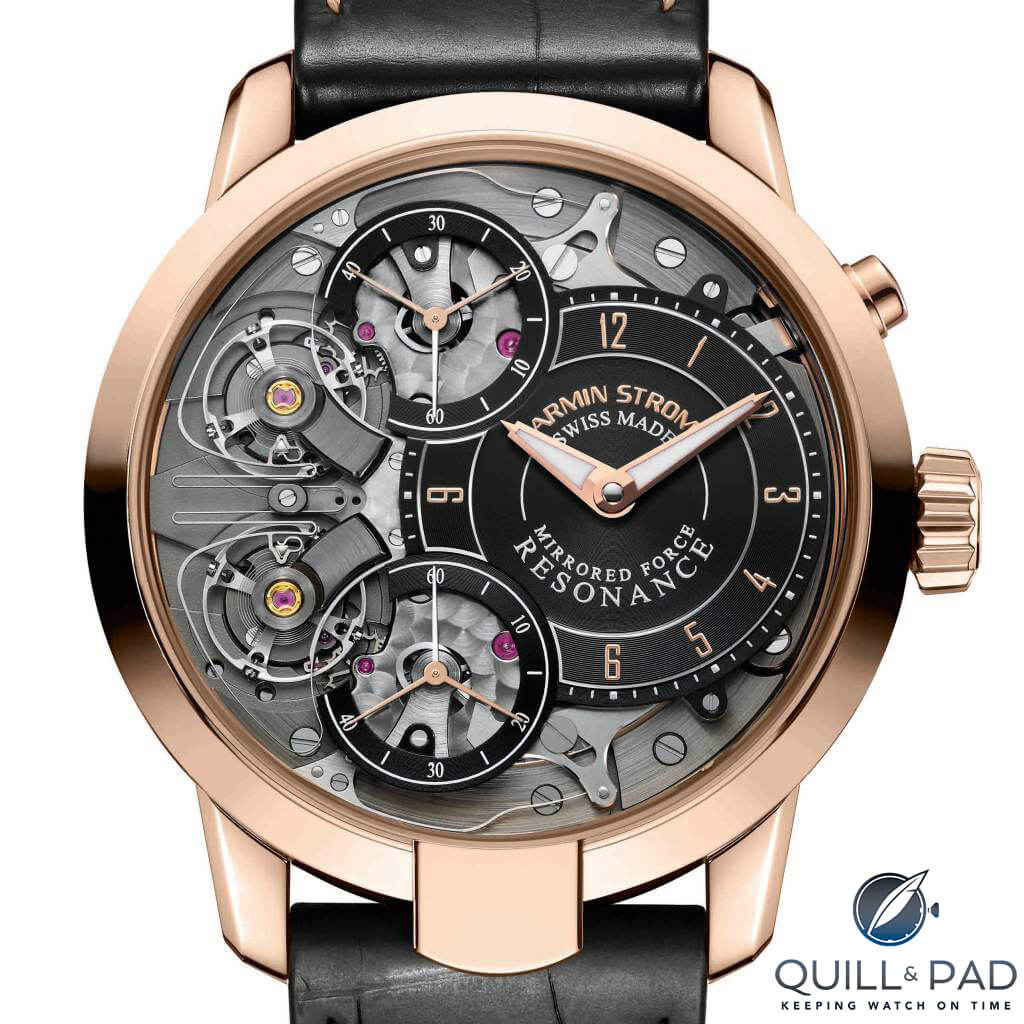
Armin Strom Mirrored Force Resonance dial
JM: I’ll begin by saying that the Armin Strom Mirrored Force Resonance is an incredible mechanical creation and, with the closest competitor pricing in at 3.6 times the price, the amount of horological value in this piece is astounding. The design and creativity behind any oscillator pair that utilizes resonance for rate stability is awesome, and the likes of this coming from a small brand like Armin Strom is seriously cool.
The visual design follows the cues already in practice from the brand, but goes down an even more technical road than usual. When all things are considered, I think this piece is a strong competitor for first place, and I personally would have a hard time saying it didn’t deserve it. Though I worry that there may be a bit more weight coming from the other brands and their own incredible pieces that Armin Strom may be overshadowed by recognition and reputation since technical merits are so close in the category.
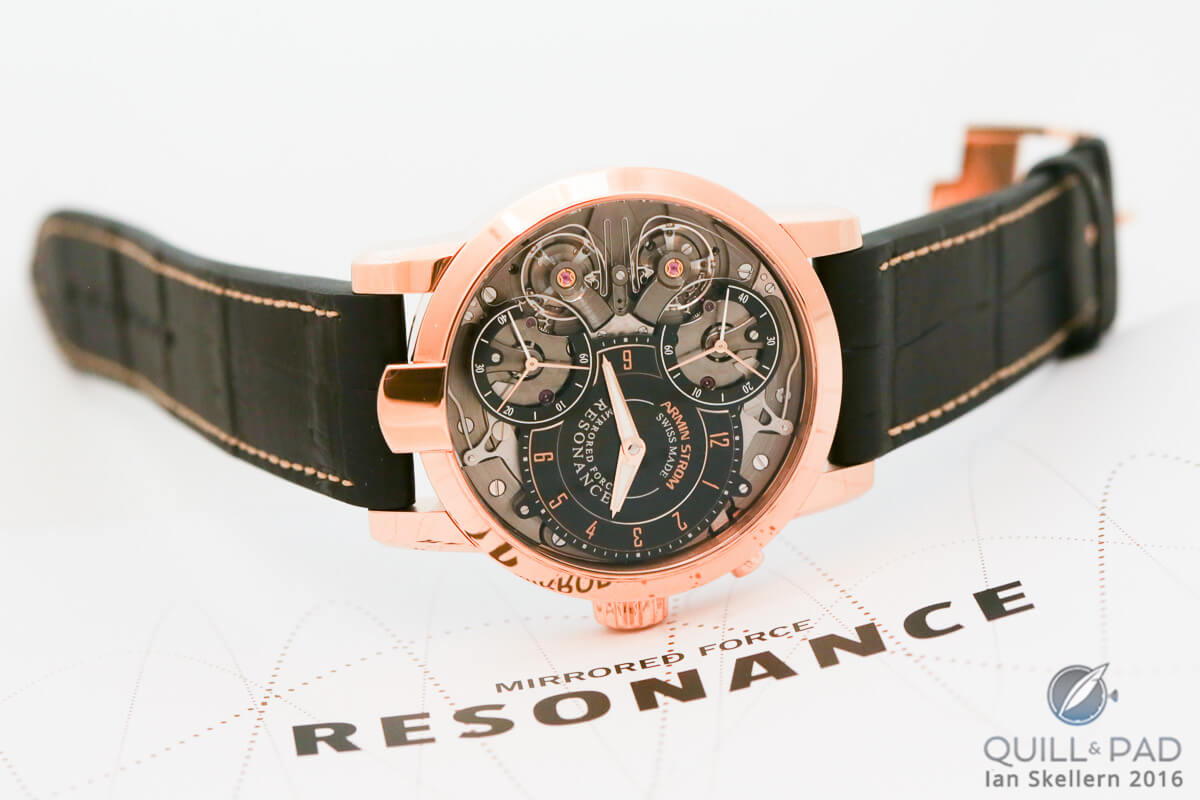
Armin Strom Mirrored Force Resonance Fire
Further reading: A Synchronistic Tour De Force: Armin Strom’s Mirrored Force Resonance
For more information see www.gphg.org/horlogerie/en/watches/mirrored-force-resonance and/or www.arminstrom.com/en/collection/mirrored-force-resonance-fire.
Quick Facts Armin Strom Mirrored Force Resonance
Case: 43.4 x 13 mm, pink gold
Movement: manually winding Caliber ARF15 with visible resonance clutch spring, two independent, symmetrically mirrored regulators beating at 25,200 vph / 3.5 Hz frequency; 48-hour power reserve
Functions: hours, minutes, twin display of luminous seconds
Limitation: 50 pieces
Price: 67,000 Swiss francs
Predicted Winners
Ian: Armin Strom Mirrored Force Resonance
Martin: Armin Strom Mirrored Force Resonance
Gary: Vacheron Constantin Les Cabinotiers Celestia Astronomical Grand Complication 3600
Ryan: Vacheron Constantin Les Cabinotiers Celestia Astronomical Grand Complication 3600
Joshua: Chopard L.U.C. Full Strike

Leave a Reply
Want to join the discussion?Feel free to contribute!